Cambridge
We are sure that there are many examples of historic lettering
in this most historic county town and university city, but this one
deserves
to be featured here:
181 Gwydir Street
'DALE'S BREWERY'
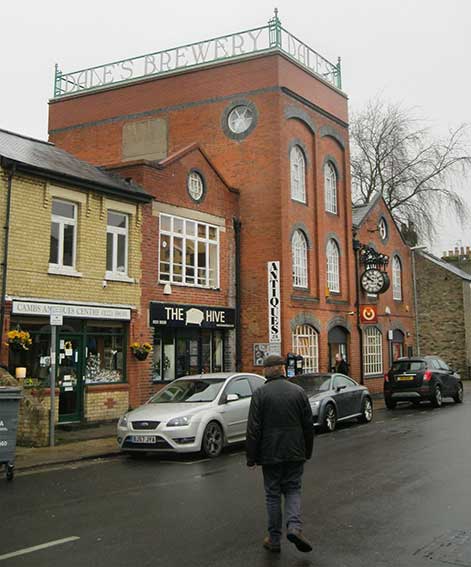
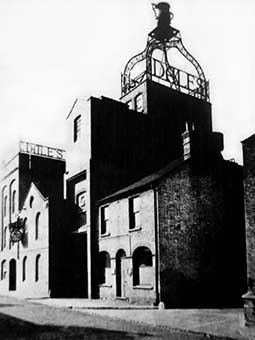 Early 20th century image
Early 20th century image
Gwydir Street, Cambridge is the location – a short walk from the
railway ststion – of Dale's Brewery,
which from the image found on Facebook (above) is today about half the
size it used to be – the photograph taken in raking sunlight was
probably taken in the early 20th century. The curious metalwork top on
the tower features not only the word 'DALES' (no possessive apostrophe,
although it appears elsewhere), but also a large, two handled trophy
supported on curving arms. Period advertisements show that a similar
yellow-painted trophy bearing the words 'GOLD CUP' are followed by a
scroll reading 'CHAMPION' to describe the beers available from the
Dale's.
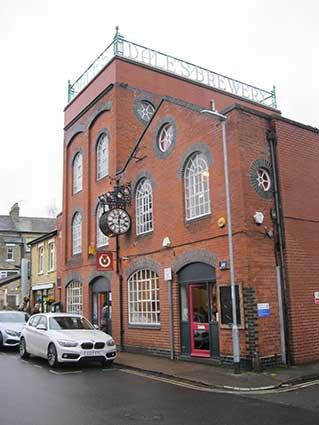
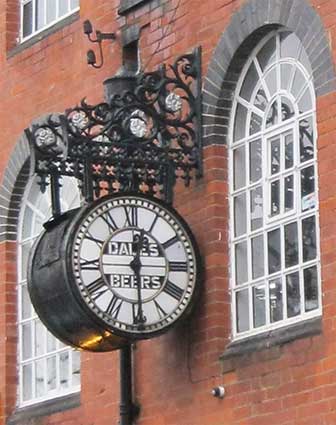 Colour images 2018
Colour images 2018
The company was founded by Frederick Dale behind the public
house The British Queen, Histon Road, Cambridge in 1898 and the Gwydir
Street brewery was built in 1902. The brewery was acquired by Whitbread
& Co. Ltd in 1954 and brewing ceased in 1958.
In fact there had been a brewery on the site since the street was laid
out and built in the 1860s expansion of the city. However, it changed
hands several times and by 1889 the original Victian buildings were
converted to stables. The new brewery was quite an impressive
structure, at least compared with many other Cambridge breweries. There
was a large three storey block fronting the street with an archway
leading to the brewery yard, plus other buildings. The large wrought
iron letters around the roof of the main building are still a feature
of the street today. The water supply for the brewery, as with many in
Cambridge, came from boreholes into the Lower Green sand, 180 feet
below the city, which provided an excellent brewing liquor.
In 1911 the brewery won a gold cup for beer of the “highest purity and
excellence” at the Brewers International Exhibition. In celebration the
7ft high copper replica of the cup was placed on the brewery building
and remained a landmark for many years. It was removed in February
1961. The success of the business and excellence of its products
resulted in supplying beer to some of the Cambridge Colleges and to the
Cambridge Boat Race crews. In 1929 Frederick Dale and his son, Lt
Colonel Guy Frederick Dale, became the company chairman until the firm
was taken over by Whitbreads, the brewery soon to be used as a bottling
plant. The site was used as a store and depot until it was sold to the
Cambridge City Council in 1966 where the archway, office and back tower
with the Champion Gold Medal where demolished.
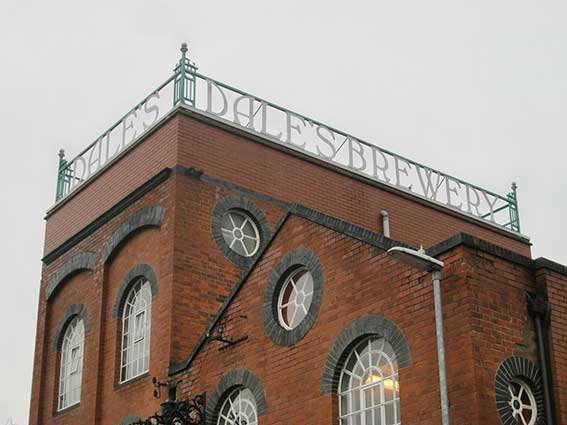
Well-designed and stylish the wrought iron lettering advertised
the brewery and marked its location from afar. It is in such good
condition, one could be forgiven for suspecting that the signs were a
relatively recent creation in 'retro/vintage' style.
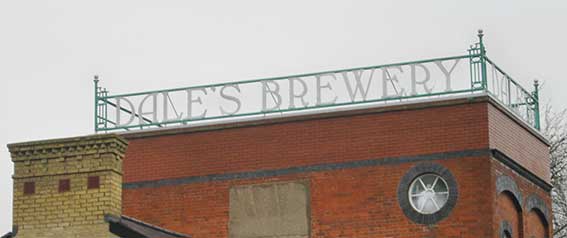
The former brewery building is opposite the David Parr House
once lived in by the decorative painter who used his house interior as
his canvas. This gem in found inside a modest terraced house and is
available for the public to view by appointment only (www.davidparrhouse.org). David
Parr worked as a principle painter for F. R. Leach and Sons – a
Cambridge firm founded in 1862 who worked with some of the best known
architects, designers and painters of the day such as William Morris,
George Bodley and Charles Kempe.
21 St Andrews Street
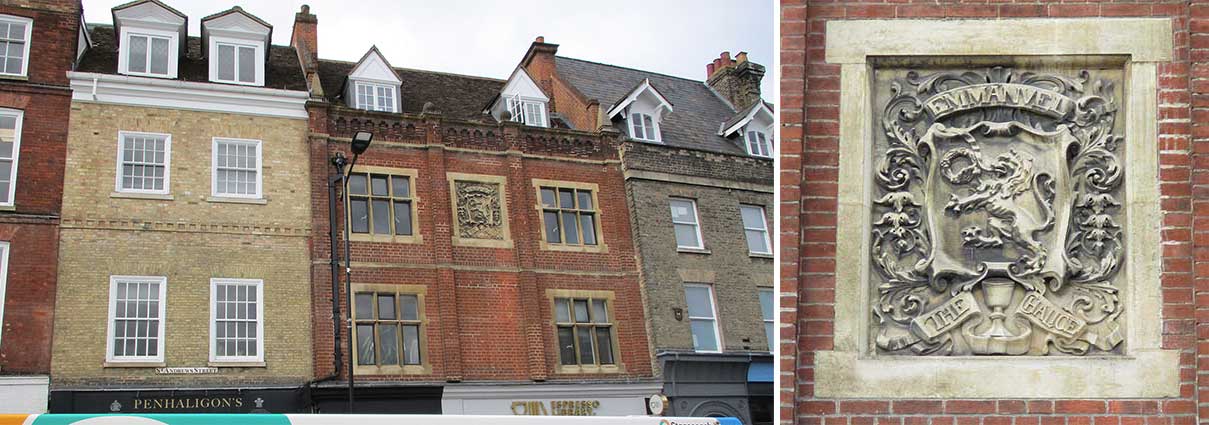 2023 image
2023 image
'EMMANUEL ... THE CHALICE'
In medieval times this property, long called ‘The
Chalice’, was the property of Corpus Christi College. It was sold and
then given to Emmanuel College (founded in 1584) by Dr Harvey in that
year. Other nearby houses were purchased by Emmanuel at the beginning
of the 17th century from a prominent Cambridge citizen called Wolfe. In
1616 the property was occupied by a seller of aquae vitae, strong
distilled alcohol. (Information from
Capturing Cambridge)
The Hobson, Downing Place, St
Andrews Street
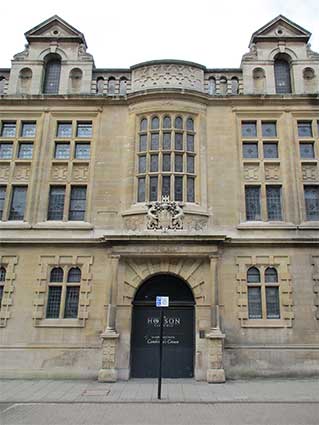
 2023 image
2023 image
'POLICE'
This is a 'boutique hotel' housed in a listed former
police station, itself a Victorian redevelopment of a site owned by
Elizabethan philanthropist Thomas Hobson. The famous phrase 'Hobson's
choice' can be traced back to a Cambridge carrier who operated a livery
stable delivering mail and providing transport to and from London in
the early 17th century. Thomas Hobson, who was born in 1545, recognised
that his best horses were in most demand and that they were also the
most overworked. He therefore devised a strict rotation system, only
allowing customers to rent the next horse in line. He rose to being a
public benefactor and Hobson's Conduit, now on Lensfield Road in
Cambridge, the Conduit Head structure stands over Hobson's Brook –
commemorating the artificial watercourse that provided much-needed
clean drinking water for the townspeople. (Information from Historic
England)
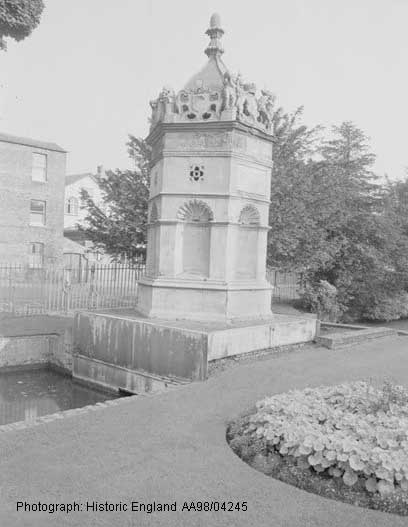
University Arms Hotel, 52-42
Regent Street
 2023 images
2023 images
'UNIVERSITY ARMS HOTEL'
It bills itself as 'Cambridge's leading Luxury Hotel
since 1834'. Revamped in 2018 this city centre hotel offers 192 rooms
with Edwardian style furnishings. The origins go back to 1833 when a
coaching inn built called the New Greyhound. By 1891 there was a range
of stables containing several coaching horses and a large coach yard.
Until the beginning of World War I there were two full time coachmen;
regular clients were the High Sheriff and those who wanted to get from
the railway station around town. It was around this time that name
changed to the University Arms Hotel. 1935: Police guarded the closed
gates of the University Arms Hotel while Sir Oswald Mosley was at a
dinner organised by the University Fascist Society. Outside, a meeting
organised by the University Socialist Society was held on Parker’s
Piece with speeches by John Comford, Maurice Comford and Maurice Dobb.
Then a torchlight procession by 200 undergraduates shouting
anti-Fascist slogans such as ‘We want Mosley dead or alive’ and singing
‘The Internationale’ marched to Peas Hill where more speeches were made
before a Proctor arrived and they dispersed. Parker's Piece is a 25
acre flat and roughly square green common located close to the hotel
and the present bar and bistro, accessed through the arcade, takes its
name from that feature. (Information mainly from Capturing Cambridge)
44 and 44A Hills Road
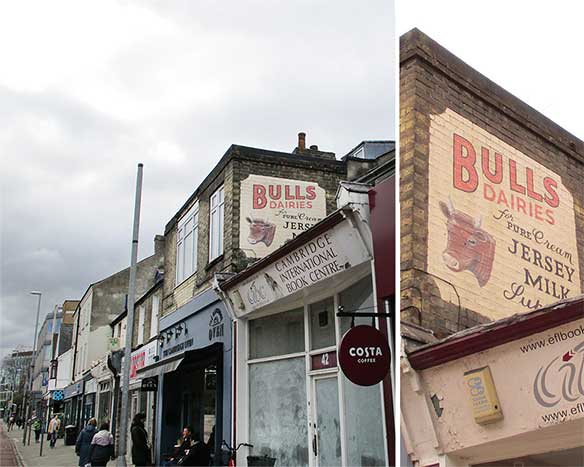
Originally a dairy, the buildings on 44 and 44A Hills
Road were bought by the Bull family in 1925 and have remained in their
possession for almost 100 years. They have had a variety of uses over
the years, including a sandwich shop and, recently, an artisan
bakery/coffee shop. The buildings still bear the original Bull’s
Dairies trade sign on each face of the projecting upper storey. The
signs have been repainted in recent years (always a contentious
practice).
'BULLS
DAIRIES
for PURE cream
JERSEY MILK
Supplied'
Within the two cream/white cartouches, the layout of
the illustration of the bull's head and accompanying text varies; the
grammar doesn't quite read correctly (one for the pedants).

The Leys School, Trumpington Road
(the A1134)
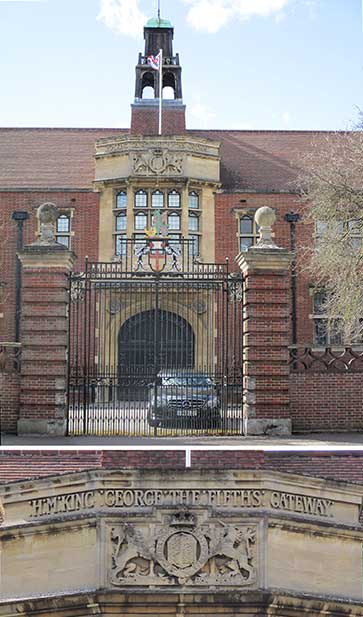
H.M. KING GEORGE THE FIFTHS GATEWAY'
The Leys was founded in 1875, a time when a large
number of schools were founded, especially by the churches. Whilst
there were already several leading schools providing an education for
the sons of Ministers, Methodists were asking for schools for the sons
of lay members. Following several visits by a committe of the Methodist
Conference to Cambridge, a twenty-acre site was discovered for sale:
The Leys Estate. The Reverend Doctor W.F. Moulton, Secretary of the
committee, was asked to become Headmaster of the new school, and The
Leys formally opened its doors in 1875 with sixteen boys from English
Methodist families. Within two years this number had grown to 100
pupils.
George V (George Frederick Ernest Albert, 1865-1936) succeeded his
father Edward VII in 1910; he was King of the United Kingdom and
the British Dominions, and Emperor of India, from 1910 until his death
in 1936. He must have visited the school to be commemorated in such
grand style by this impressive gateway.
23 Trumpington Street

'OUTPATIENTS'
Browns Cambridge is housed in the historic old 19th
century
Addenbrooke’s Hospital, now lovingly converted into a bright, airy and
modern brasserie and bar, with a delightful outdoor courtyard. The
modern Addenbrookes Hospital is in Hills Road to the south of Cambridge.
28-30 Trumpington Street
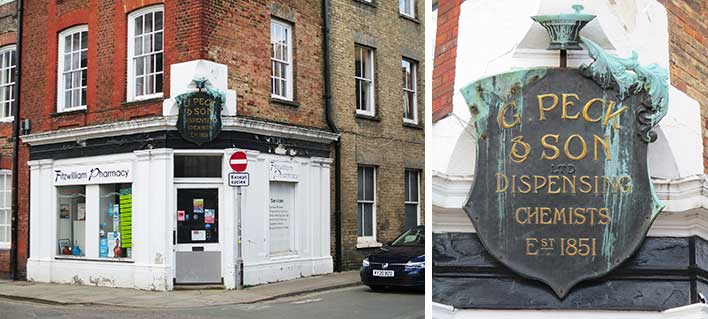
'G. PECK
& SON
[LTD]
DISPENSING
CHEMISTS
EST 1851'
The ampersand is particularly flamboyant and the tiny
'LTD' has not been gilded. George Peck (1827-1909) set up as a chemist
in
Trumpington Street, in his home town of Cambridge, in 1851. Three of
his eleven children followed in his footsteps by becoming pharmacists.
Ernest Saville Peck, the eldest, assumed the reins on his father’s
retirement in 1904. The large bronze shield above the corner door is
topped by a pestle and mortar, symbols of the apothecary, but is
missing one of the acanthus leaf decorations. (Information from Building
our past)
Tennis Court Road, sundial
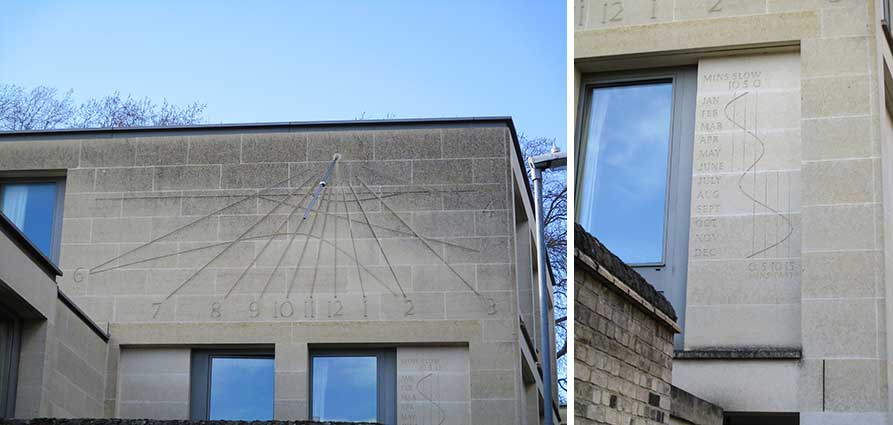
This modernist sundial with its projecting silver
gnomon and numerals incised into the wall's surface is close to Tennis
Court Terrace off of which is the entrance to Pembroke College Master's
Lodge. This dial is on the wall of Foundress Court and was designed by
Eric Parry Architects and built in 1997. It won a commendation from the
British Sundial Society. The helpful graph lower right shows that in
February sundials are about 15 minutes slow of Greenwich Mean Time
(GMT). The shadow of the ball (halfway down the gnomon) indicates the
season, falling on the upper or lower curves at the solstices, and the
straight centre line at the equinoxes. (Information from Geograph)

 Early 20th century image
Early 20th century image
 Colour images 2018
Colour images 2018

 2023 image
2023 image
 2023 image
2023 image
 2023 images
2023 images




